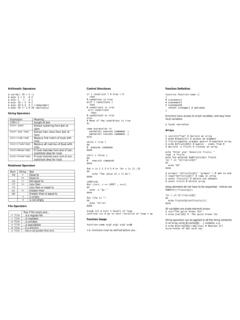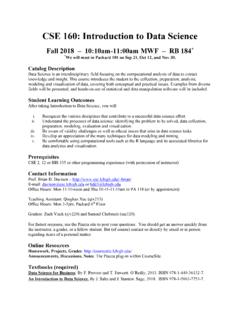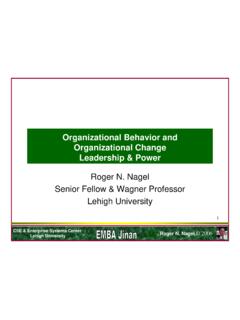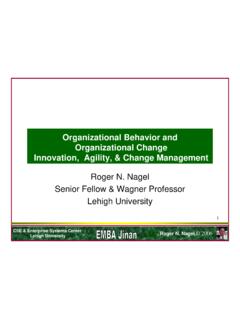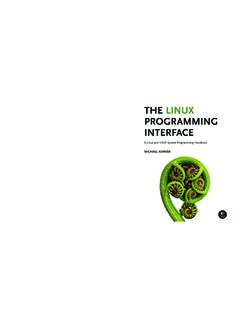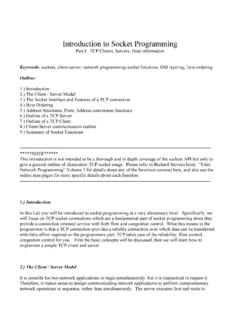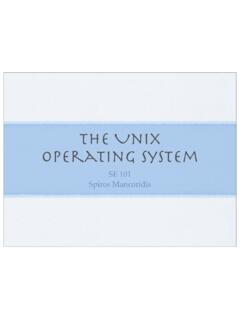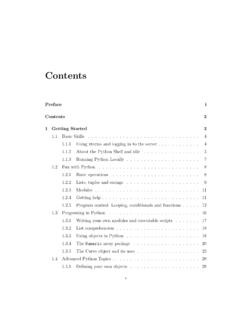Transcription of CSE 265: System and Network Administration
1 Spring 2012 CSE 265: System and Network Administration 2004-2012 Brian D. DavisonCSE 265: System and CSE 265: System and Network AdministrationNetwork AdministrationMW 9:10-10:00am Packard 258F 9:10-11:00am Packard 112 ~brian/course/sysadmin/Find syllabus, lecture notes, readings, :Prof. Brian D. 2012 CSE 265: System and Network Administration 2004-2012 Brian D. DavisonWho is this course for?Who is this course for? Students interested in learning The roles and responsibilities of a computer systems and Network administrator How to configure & manage their own linux systems How to diagnose and debug problems How some of the major System services operate Why they need to be nice to the sysadmin unix /Linux familiarity and programming experience required (CSE17)Spring 2012 CSE 265: System and Network Administration 2004-2012 Brian D.
2 DavisonWhat will the course cover?What will the course cover? Understand the role & responsibilities of a System administrator Configure the Linux operating System Describe the System boot process Setup and manage user accounts and groups Manage the resources and security of a computer running Linux Make effective use of unix utilities and scripting languages (bash, Perl) Configure and manage simple Network services on a Linux System Develop an appreciation of the documentation available as part of an installed unix /Linux systemSpring 2012 CSE 265: System and Network Administration 2004-2012 Brian D. DavisonWhat will it not cover?What will it not cover? Networking in depth Take CSE342 or CSE404 instead Network security in depth Take CSE343 instead Windows Administration Many hardware issues All the details needed for certification Lots of certification courses availableSpring 2012 CSE 265: System and Network Administration 2004-2012 Brian D.
3 DavisonWhat will it not cover?What will it not cover? Networking in depth Take CSE342 or CSE404 instead Network security in depth Take CSE343 instead Windows Administration Many hardware issues All the details needed for certification Lots of certification courses availableSpring 2012 CSE 265: System and Network Administration 2004-2012 Brian D. DavisonWhat does a sysadmin do?What does a sysadmin do?Spring 2012 CSE 265: System and Network Administration 2004-2012 Brian D. DavisonWhat does a sysadmin do?What does a sysadmin do? User account management Hardware management Perform filesystem backups, restores Install and configure new software and services Keep systems and services operating Monitor System and Network Troubleshoot problems Maintain documentation Audit security Help users, performance tuning, and more!
4 Spring 2012 CSE 265: System and Network Administration 2004-2012 Brian D. DavisonUser Account ManagementUser Account Management User Ids Mail Home directories (quotas, drive capacities) Default startup files (paths) Permissions, group memberships, accounting and restrictions Communicating policies and procedures Disabling / removing user accountsSpring 2012 CSE 265: System and Network Administration 2004-2012 Brian D. DavisonHardware ManagementHardware Management Capacity planning Inventory Hardware evaluation and purchase Adding and removing hardware Configuration Cabling, wiring, DIP switches, etc. Device driver installation System configuration and settings User notification and documentationSpring 2012 CSE 265: System and Network Administration 2004-2012 Brian D. DavisonData BackupsData Backups Perhaps most important aspect!
5 Disk and backup media capacity planning Performance, Network and System impact Disaster recovery Onsite/Offsite Periodic testing Multiple copies User communication Schedules, restore guarantees and procedures, loss toleranceSpring 2012 CSE 265: System and Network Administration 2004-2012 Brian D. DavisonSoftware Installation/MaintenanceSoftware Installation/Maintenance Evaluation of software Downloading and building (compiling and tweaking) Installation Maintenance of multiple versions Security Patches and updates User notification, documentationSpring 2012 CSE 265: System and Network Administration 2004-2012 Brian D. DavisonSystem MonitoringSystem Monitoring Hardware and services functioning and operational Capacity Disk, RAM, CPU, Network Security Passwords Break-ins System logs Examination Periodic rotation and truncationSpring 2012 CSE 265: System and Network Administration 2004-2012 Brian D.
6 DavisonTroubleshootingTroubleshooting Problem discovery, diagnosis, and resolution Root cause analysis Often quite difficult! Often requires Broad and thorough System knowledge Outside experts Luck ExpediencySpring 2012 CSE 265: System and Network Administration 2004-2012 Brian D. DavisonLocal DocumentationLocal Documentation Administrative policies and procedures Backup media locations Hardware Location Description, configuration, connections Software Install media (or download location) Installation, build, and configuration details Patches installed Acceptable use policiesSpring 2012 CSE 265: System and Network Administration 2004-2012 Brian D. DavisonSecurity ConcernsSecurity Concerns System logging and audit facilities Evaluation and implementation Monitoring and analysis Traps, auditing and monitoring programs Unexpected or unauthorized use detection Monitoring of security advisories Security holes and weaknesses Live exploitsSpring 2012 CSE 265: System and Network Administration 2004-2012 Brian D.
7 DavisonUser AssistanceUser Assistance Time intensive! Techniques Help desks Trouble-ticket systems Software availability and usage Software configuration settings Hardware usage, maintenance, and troubleshooting Writing FAQsSpring 2012 CSE 265: System and Network Administration 2004-2012 Brian D. DavisonAdministration ChallengesAdministration Challenges Need Broad knowledge of hardware and software To balance conflicting requirements Short-term vs. long-term needs End-user vs. organizational requirements Service provider vs. police model To work well and efficiently under pressure 24x7 availability Flexibility, tolerance, and patience Good communication skills People think of sysadmins only when things don't work!Spring 2012 CSE 265: System and Network Administration 2004-2012 Brian D.
8 DavisonWhich OS to learn to admin?Which OS to learn to admin?Spring 2012 CSE 265: System and Network Administration 2004-2012 Brian D. DavisonWhy (Red Hat/CentOS) Linux?Why (Red Hat/CentOS) Linux? Need to use some OS to make ideas concrete Really only two choices: Windows (I'm not qualified) unix (and unix -like OSes such as Linux) Both are useful and common in the real world Linux is popular, free, and usable on personal machines, but also handles large-scale services Red Hat/CentOS is relatively polished, popular I've been using it since ~1996 There are, of course, many alternativesSpring 2012 CSE 265: System and Network Administration 2004-2012 Brian D. DavisonWhat is Linux?What is Linux?much is courtesy of is courtesy of Linux is a clone of the operating System unix , written by a loosely-knit team of hackers across the Net.
9 It aims towards POSIX and Single unix Specification compliance. Like any modern fully-fledged unix , Linux includes true multitasking, virtual memory, shared libraries, demand loading, shared copy-on-write executables, proper memory management, and TCP/IP networking. Linux really refers to the kernel most of the commands that you are familiar with are really separate programs, not specific to Linux, and often are part of the Free Software Foundation's GNU project. Linux was first developed for 32-bit x86-based PCs (386 or higher). These days it also runs on dozens of other 2012 CSE 265: System and Network Administration 2004-2012 Brian D. DavisonBrief history of UNIXB rief history of unix Originated as a research project in 1969 at AT&T Bell Labs Made available to universities (free) in 1976 Berkeley unix started in 1977 when UCB licensed code from AT&T.
10 Berkeley Software Distribution started in 1977 with 1 BSD, and ended in 1993 with Licensing costs from AT&T increased, so Berkeley attempted to remove AT&T code, but ran out of funds before completion. Final release of AT&T-free code called Most current BSD distributions (FreeBSD, NetBSD, OpenBSD) are derived from Most commercial versions of unix (Solaris, HP-UX) are derived from the AT&T codeSpring 2012 CSE 265: System and Network Administration 2004-2012 Brian D. DavisonBrief history of LinuxBrief history of Linux Created as a personal project (and still controlled) by Linus Torvalds, a Finnish graduate student, in 1991 Conceived as an offshoot of Minix (a model OS) Not derived from AT&T or BSD unix Red Hat (one of many Linux vendors) founded in 1993 Kernel released 1994 Most recent (Jan 2012) kernel release is 2012 CSE 265: System and Network Administration 2004-2012 Brian D.
